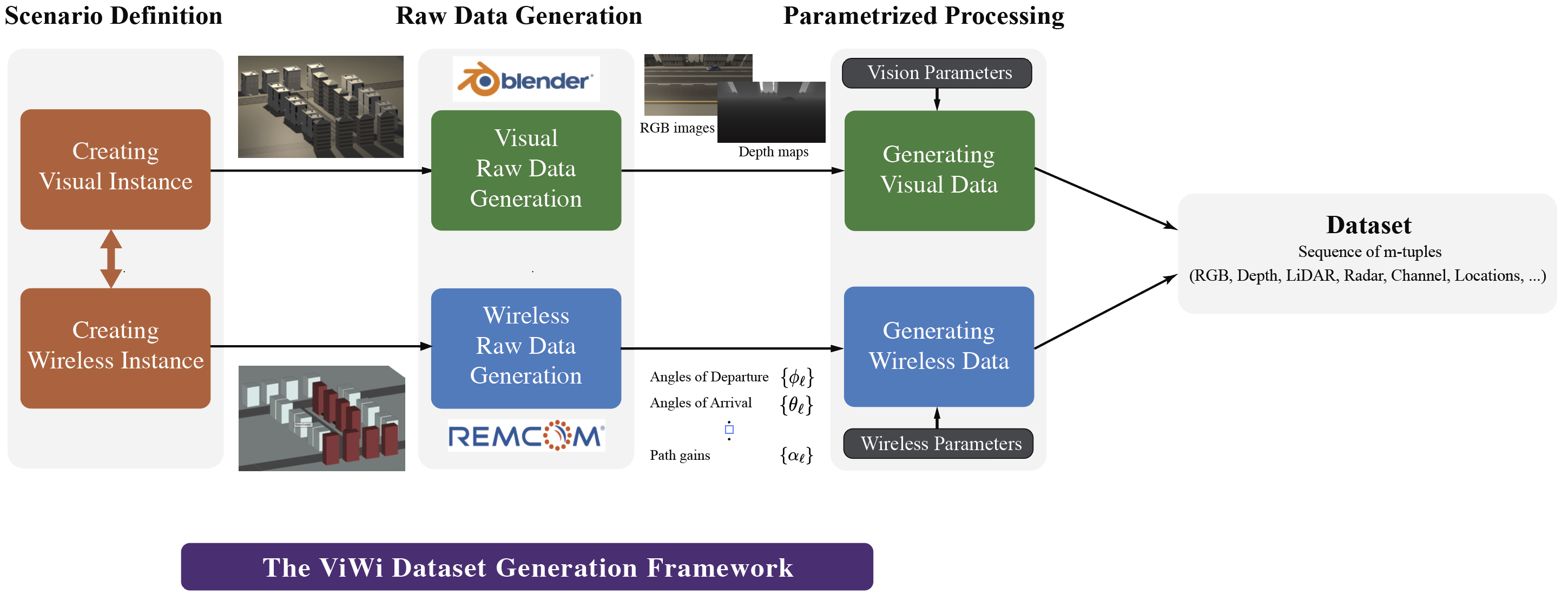ViWi: A Deep Learning Dataset Framework for Vision-Aided Wireless Communications

Paper (Dataset Description)
Version 1: M. Alrabeiah, A. Hredzak, Z. Liu, and A. Alkhateeb,"ViWi: A Deep Learning Dataset Framework for Vision-Aided Wireless Communications" submitted to IEEE Vehicular Technology Conference, Nov. 2019.
Citation and License
In order to use the ViWi datasets/codes or any (modified) part of them, please cite
- The ViWi paper: M. Alrabeiah, A. Hredzak, Z. Liu, and A. Alkhateeb,"ViWi: A Deep Learning Dataset Framework for Vision-Aided Wireless Communications" submitted to IEEE Vehicular Technology Conference, Nov. 2019.
@InProceedings{Alrabeiah19,
author = {Alrabeiah, M. and Hredzak, A. and Liu, Z. and Alkhateeb, A.},
title = {ViWi: A Deep Learning Dataset Framework for Vision-Aided Wireless Communications},
booktitle = {submitted to IEEE Vehicular Technology Conference},
year = {2019},
month = {Nov.},
} - The Remcom Wireless InSite website: Remcom, Wireless insite,
https://www.remcom.com/wireless-insite
The ViWi dataset is licensed under a Creative Commons Attribution-NonCommercial-ShareAlike 4.0 International License
 .
.
Generating a dataset using ViWi
Version 1
Download the
 and a single-user scenario of interest.
and a single-user scenario of interest.Unzip the scenario directory and the data-generation package.
Move the folder named "wireless" from the scenario main directory to the "RayTracing Scenarios" directory in the data-generation package, and re-name it accourding to the prefix of the the files in "wireless" (see inclosed README.txt for an example).
Add the root directory "ViWi_wireless_data" and its subdirectories to the MATLAB path.
Go to the file Dataset_Genrator.m and setup your dataset parameters.
In MATLAB command line, issue the following command: Dataset = Dataset_Generator('scenario'), where 'scenario' is the name of the scenario directory in 'RayTracing Scenarios'.
The returned variable 'Dataset' contains the wireless channels of the scenarion.
Version 2
Download the
 and a multi-user scenario of interest.
and a multi-user scenario of interest.Unzip the data-generation package "gen_scripts_ViWi_v2.zip" and place its content into a root directory named "gen_scripts_ViWi_v2" (or any name of your choice). You should get a MATLAB generation script named "main.m," and a directory named "MAT functions".
Move the scenario zipped files to the root directory.
Unzip the modality files inside the root directory to get several directories, e.g., wireless data has directory named RayTracing, visual data has directory named visual_data,...etc.
Unzip the scenario attribute file "scenario_attrib.zip"
Add the directories "MAT functions" and "scenario_attrib" and their subdirectories to the MATLAB path.
In main.m, set up you dataset parameters, and run the file to generate a raw ViWi dataset.
At the end of the run, a raw dataset is produced and organized in a MATLAB data structure named "raw_data".
Questions and bug reports
Should you have any question or want to report a bug, please do not hesitate to reach out to:Muhammad Alrabeiah: malrabei@asu.edu
Gouranga Charan: gcharan@asu.edu
Ahmed Alkhateeb: alkhateeb@asu.edu
Join the ViWi mailing list!
Please provide your contact information to get the latest updates about the ViWi dataset